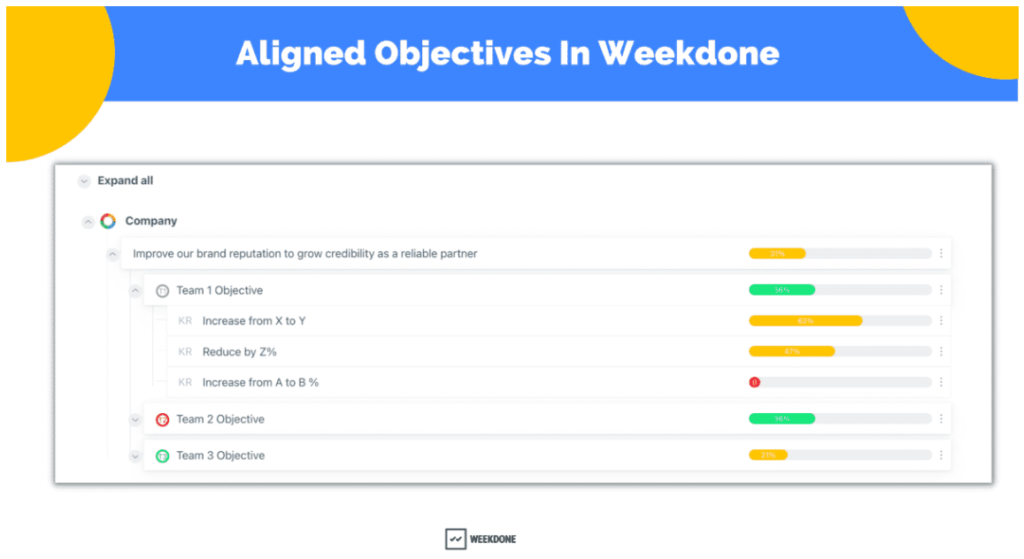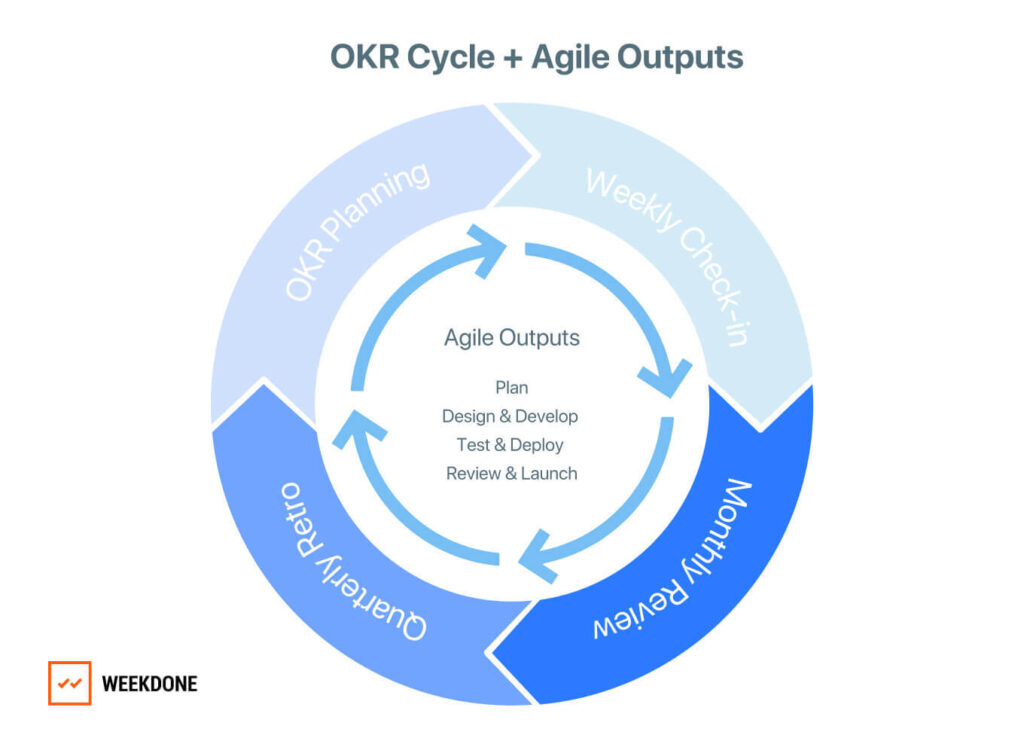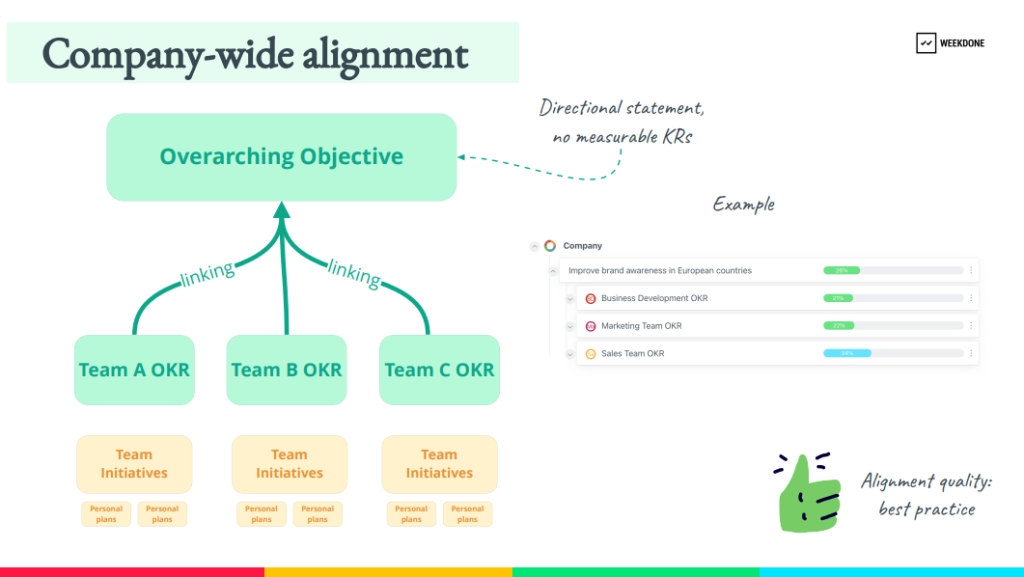The conventional practice adopted to pursue a long-term vision has been to set yearly, ambitious Objectives and Key Results (OKRs). But in today’s rapidly evolving environment shifting from annual to quarterly goal planning can provide the agility needed to make changes.
The question is – “Annual vs Quarterly OKRs – what works better?”
While it is important to have annual goals, you must also set quarterly OKRs. Why? Because it helps you and your team stay focused, increase employee engagement, and drive improvements every quarter, month, and week.
A strong connection has been observed between employee engagement and performance outcomes – such as profitability, productivity, and retention.
Gallup estimates that low engagement costs the global economy US$7.8 trillion and accounts for 11% of GDP globally.
Gallup’s State of the Global Workplace 2022 Report
Already created your annual and quarterly goals? How do you plan to set, track, and measure your OKRs?
OKR Framework Basics
The OKR framework is a quarterly goal-setting strategy that consists of 2 crucial components:
- Objectives: Qualitative goals that clarify what you want to improve
- Key Results: Quantitative metrics that define whether or not you’ve achieved a specific objective
OKRs are driven by Initiatives which are the particular plans and projects implemented to achieve a given Objective.
OKRs are also reviewed through OKR Weekly Check-ins. This allows you to monitor team members’ accomplishments, discuss potential problems, and evaluate upcoming plans and projects.
How Often Should OKRs Be Set?
When choosing between annual vs quarterly OKRs, remember that yearly strategic goals are important but a smarter approach is to have specific quarterly OKRs linked to annual goals.
Quarterly goals are ideally linked with your annual OKRs and it shows what you need to do every quarter to accomplish your annual plan. It breaks down goals into action plans of what needs to be done to succeed and the impact of short-term initiatives on long-term vision.
Here’s a simple process you can adopt when setting OKR quarterly:
- Set a quarterly Objective at the company level
- Allow all teams to create their Team Objectives to support the Company’s Objective
- Ensure that teams create at least 3 to 5 Key Results and Initiatives for every quarterly Team Objective
Following this easy process, team managers and leaders can set quarterly Objectives that can maintain the focus of their team and link to these quarterly company Objectives.
What is a Quarterly OKR Cycle?
A quarterly OKR cycle is ideally 3 months and can be approached in a step-by-step manner:
- At the beginning of every quarter, identify specific Objectives and the Key Results you’ll use to monitor progress
- During the quarter, use Initiatives and Weekly Plans to break up your quarterly goals into smaller actionable steps.
- At the end of the quarter, conduct an OKR review or OKR evaluation to see how successful your team was.
Each quarterly OKR cycle should bring your team closer to accomplishing the larger annual Objectives you set for the entire year.
Annual vs Quarterly OKRs? Why Quarterly Goals Work Better
Want to know why quarterly OKRs work better than annual goals? Here are some of the reasons:
1. Improve Goal Alignment
Quarterly OKRs ensure that your team’s goals are aligned with the larger company goals and Objectives. This makes it easier for teams to contribute to the greater company vision and improve overall company performance.
2. Increase Focus
Setting ambitious Objectives and identifying measurable Key Results helps to increase focus. This approach clarifies what each team member should be working on during the quarter. It also provides a system for them to measure their progress throughout the quarter.
3. Boost Productivity
More focused team members can see how they’re progressing toward their larger Objectives making them more productive. This makes your team more capable of accomplishing their goals faster and provides an effective strategy to utilize time and resources efficiently.
4. Add More Accountability
Quarterly OKRs, especially when used with an effective OKR software can create more accountability among team members. By assigning ownership for every Key Result and Initiative, tracking OKRs can give visibility into the progress made towards accomplishing goals and the support required.
👇 Want to see the benefits of setting quarterly OKRs in real time?
“How Do You Make Quarterly OKRs?” 4 Best Practices
No matter your choice between annual vs quarterly OKRs, creating relevant objectives and key results requires a smart approach and forward-looking outlook. Here are some of the best practices to keep in mind to help you visualize, create, and score your OKRs using proven methodologies.
1. Create Aspirational and Ambitious OKRs
When identifying Objectives and Key Results, make sure they are ambitious and aspirational. Set goals and choose Key Results that will require you and your team members to push yourselves and step outside of your comfort zone to succeed.
2. Make Measurable OKRs
While the Objective in the OKR framework should be qualitative, the Key Results must be quantitative and measurable. You and your team should define exactly what it means to be “successful” at achieving a particular Objective. Creating measurable Key Results allows you to assess progress and identify and justify improvement areas.
3. Develop an Agile OKR Strategy
Agility means the ability to change and adapt quickly. Develop an OKR strategy that is agile by identifying regular opportunities to evaluate progress, identify problems, and make adjustments to goals as needed.
4. Identify More Opportunities for Improvement
OKRs should ideally be planned and evaluated every quarter. This gives teams at least four opportunities annually to assess their OKRs, make changes, and stay aligned with the company’s overarching mission and goals.
💡Curious to see how applying these best practices can make a difference in your goal-setting process?
OKR Examples
Consider some of these quarterly OKR examples to get a better understanding of the framework and how it can help you create smarter goals:
Quarterly OKR Example 1
Objective: Improve the way our team manages warehouse inventory records so we can save time on inventory checks
- Key Result 1: Reduce the average time needed to complete inventory checks from 12 hours to 3 hours
- Key Result 2: Automate 2 critical inventory check processes to minimize human error
- Key Result 3: Reduce bookkeeping data and factual information discrepancies from 5% to 2%
Quarterly OKR Example 2
Objective: Research and gain a deeper understanding of customer churn
- Key Result 1: Receive a 35% response from the customer churn survey
- Key Result 2: Conduct interviews with 10% of respondents to gain more insight
- Key Result 3: Analyze responses and identify 2 specific issues on which we can improve
Quarterly OKR Example 3
Objective: Improve the company’s recruitment process and increase candidate satisfaction ratings
- Key Result 1: Decrease the average rejected candidate feedback time from 12 to 6 days
- Key Result 2: Reduce the number of recruitment meetings from 5 meetings to 3
- Key Result 3: Increase final round candidate satisfaction rating from 65% to 95%
Quarterly OKR Example 4
Objective: Improve search engine ranking for cornerstone content
- Key Result 1: Increase the number of backlinks for 12 cornerstone content articles to at least 6
- Key Result 2: Publish 8 guest blog posts with links to cornerstone content on sites with domain authority of 40 or higher
- Key Result 3: Ensure 100% of cornerstone content loads within 2 or fewer seconds
Quarterly OKR Example 5
Objective: Successfully launch version 2.0 of our company’s main product
- Key Result 1: Generate at least 12,000 new signups
- Key Result 2: Publish product reviews in at least 10 publications
- Key Result 3: Improve our On-time Delivery rate from 70% to 85%
💡 Searching for more OKR examples? See 100+ OKR examples for teams
Take the next step and use these examples in an OKR software.
What Does the OKR Process Look Like?

Consider this process when setting quarterly and annual OKRs, whether you’re working with an OKR spreadsheet or using a dedicated OKR management tool:
1. Plan Your Company Annual OKRs
Your yearly Company Objective should represent the long-term progress you want to make at your company. Where do you want to be 12 months from now? These annual goals should only exist at the company level of OKRs.
2. Set Quarterly Goals to Match the Annual OKRs
Next, identify quarterly Objectives that align with the yearly Objective. Where can you be in the next 3 months that will move you closer to where you want to be in 12 months? Quarterly Company Objective gives guidance to teams for setting their OKRs for the first quarter of the year.
3. Set Team-Level OKRs
Translate your Company Objective into team-level Objectives that each department can work toward. Ensure that measurable Key Results for each Team Objective are created.
💡 Keep in mind that teams only need quarterly OKRs.
Setting team goals for 12 months makes it too abstract for employees. When annual OKRs for teams are set the common thought is that “I still have time to deal with this later”. Instead, with quarterly OKRs, team members can focus on goals that have an immediate impact which not only makes them more productive but also motivates them.
4. Add Initiatives to Drive Team OKRs
The next step in the process is to identify specific OKR Initiatives (plans and projects) that each team can use to drive progress toward accomplishing their Objectives and Key Results.
5. Create Weekly Plans Under OKRs
Create weekly plans for quarterly OKRs to break down the Objective into actionable plans. This helps clarify what everyone should be working toward in the present.
6. Connect OKRs, Initiatives, and Weekly Plans
Connect your OKRs, larger Initiatives, and Weekly Plans in one platform to get a clear view of the progress and the change in focus required.
👇 Simplify the connection between Objectives, Key Results, Initiatives, and Weekly Plans
7. Update and Track Your OKRs Progress Weekly
Ensure that everyone is regularly updating and tracking their OKRs. This helps to stay up-to-date on each team member’s progress so you can provide feedback and recognition as needed.
8. Conduct a Quarterly OKRs Review
At the end of every quarter, when the OKR cycle is complete, assess your OKR progress. Conduct a quarterly review to discuss those Objectives that were successful and those that need improvement. This gives you a chance to create better OKRs for the upcoming quarter.
💡 Want to know how to launch OKRs successfully? Watch this:
Use Quarterly OKRs to Achieve More With Less
When the business environment demands flexibility and agility, setting quarterly OKRs can be the perfect way to adapt and achieve your long-term business goals.
Key Takeaways
- OKRs consist of Objectives (qualitative goals) and Key Results (quantitative metrics) that help define your team’s and company’s success.
- OKRs can be set for different teams and roles within teams. Take inspiration from these OKR examples created for different job positions.
- OKRs must be ambitious, measurable, agile, and quarterly. Accelerate the adoption curve by using these OKR best practices.
- When planning OKRs, remember that an ideal OKR cycle is a quarter (3 months) after which you can review and grade them.
To monitor progress, conduct regular check-ins, and stay on track, best-in-class companies are using OKR software to take their goal-setting to the next level.
🎯 Have you created your quarterly and annual goals yet? Choose a smart approach to goal-setting.





